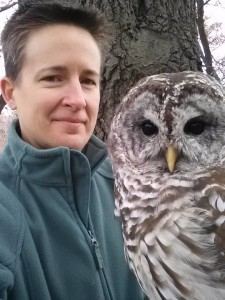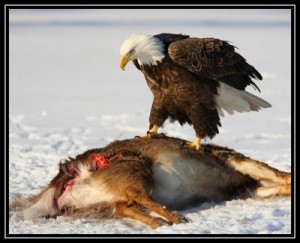
Me with one of the raptors I volunteer with at Richardson Nature Center. This owl is in captivity only because it was fed by humans and became imprinted.
Many people apply the term “baiting” to include anything from setting up backyard bird feeders to harassing a raptor with live prey. I think it’s important to define what baiting is, how I see it as being different from other activities it is often compared to (a way baiters try to justify the practice), and why I believe it is harmful.

Eagle on deer carcass – someone had pulled road kill away from the road for the safety of the eagles. Although it did involve humans, this is NOT baiting.
My definition of baiting is: actively luring an individual bird (usually a raptor) with live (or simulated live) prey, in order to provoke hunting behavior which brings the bird in close proximity to the observer, for purposes such as bird watching or photography, outside the scope of regulated activity such as falconry, scientific research and wildlife rehabilitation.
This differs from other types of bird feeding/attracting in the following ways:
- Bird feeders (including seed, suet, nectar, fruit, live mealworms) do not target individual birds. The birds are free to come and go on their own. This type of feeding is widely supported and encouraged by organizations such as the Audubon Society, American Birding Association, Cornell Lab of Ornithology, etc.
- Bird banding is highly regulated, done for research purposes, by qualified banders who must follow specific procedures and obtain state/federal permits to do so. Similarly, falconers are regulated and must obtain permits.
- Hand feeding backyard birds – many people compare this to baiting. It is different because the types of birds who will come to the hand are already by nature quite tame (chickadees, nuthatches, etc.) and already coexist with humans in backyard environments. They are species that are not dependent on one type of food for their survival. One can debate whether hand feeding songbirds is itself problematic, but regardless, it is different from baiting a raptor.
- Setting up perches near or on feeders for photography. This does not target an individual bird, nor provoke any behavior that interferes with a bird’s normal actions. And usually a photography “studio” setup like this attracts songbird species that are already accustomed to humans, or the observer uses a blind for more skittish species. There is no new human=food association that is formed as a result.
I believe baiting (as I defined above) is harmful because:
- Raptors are very prey oriented. They are easily ritualized and become habituated to humans when they associate us with a food source. This can result in the bird swooping in on people or even cars in anticipation of being fed (it has been documented many times here in MN.) This is unsafe for birds and humans.
- A bird that is baited is not just baited once. Typically it is baited repeatedly over a period of time by one or more photographers/birders. It often involves the bird being harassed/stressed by the behavior of those who are trying to get a closer view and can lead to illegal activities such as trespassing on private property.
- If the bait is live, it is usually a domestic pet store mouse. This is not the natural diet of a wild bird and there is the possibility of disease that may result from unsanitary conditions that these mice are raised in. And there is the possibility that the prey may escape and that is neither fair to the mouse nor good for the environment.
- If the bait is artificial, the the bird is wasting time and effort chasing a lure when that energy should be spent hunting. This significantly interferes with the bird’s ability to survive.
- Baiting is often done near roadsides which puts these birds in danger of being hit by a car.
- I am not aware of any birding or wildlife rehab organization that supports baiting. However several oppose it, including the Raptor Center, Owl Foundation, and Raptor Education Group. Also the ethical guidelines of groups like the American Birding Association and North American Nature Photography Association strongly discourage activities which interfere with a bird’s natural behavior.
For those who defend baiting, it’s interesting to ask if a) they have ever been involved with wildlife rehabilitation, and b) can they produce any statement or evidence of a birding/research/wildlife rehab organization which supports baiting as something that should be practiced by the general public. I’ve never gotten a direct answer to those questions from any baiting apologist. I think that says a lot.
Further reading:
Here is an excellent blog post by an Ottawa birder about baiting, which goes into much more detail.
Local ornithologist and author Laura Erickson on baiting: Baiting Owls
